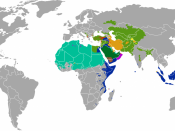Due to his conscious knowledge of the importance of Usul al-Fiqh and his enthusiasm to see Shari'ah laws being upheld in Muslim countries, Imran Ahsan Khan Nyazee had come up with a comprehensive book offering a broad introduction to Islamic legal theories. His aim is to provide clear and concise theoretical foundations on the subject for students and beginners, as well as answering uncertainties, queries and misconceptions which specialists might have pertaining to the topic. He managed to simplify its contents, without sacrificing his high scholarly standards as per his other works, making it a suitable read for people of varying academic levels. He hopes that his readers would be able to apply some of the basic skills he provided upon further study of the subject.
In his book, Nyazee gives a broad range of examples and analogies to help his readers understand the terms better. He often includes tables, comparison charts, diagrams and highly detailed footnotes to give users quick reference to certain issues and summarises the main points to facilitate their learning process.
Also included are detailed bibliographies of books he referred to, and even divided them into Arabic books and English ones. A Glossary section is also available for users to look up the meanings of the terms used, thus making it a complete textbook for students and beginners.
For most of the topics, he usually makes comparisons between the rulings and opinions of well known schools of thought and their jurists. Among those widely referred to are the Hanafis, Syafi'is, Malikis and Hanbalis, with the occasional reference to the Sufis and Mu'tazilah. Thus, it covers a comprehensive analysis of views from the different scholars available. In doing so, the book is able to capture a wider range of audience, and at the same time, allows one to have further understanding of the different perspectives of jurists apart from his own. Nyazee also made comparisons between jurists of earlier times, stressing their importance and gratitude for their work, with those of the modern era. As an Associate Professor in the Faculty of Shariah and Law in Islamabad, Nyazee often cites examples and refers to the political system being practiced in Pakistan when discussing legal rules in modern society.
As an introductory book to Islamic Jurisprudence, Nyazee came up with an outline of the Islamic legal system used in the past and its development in the present. He began by laying out the meanings and terms used in the discipline of Jurisprudence. He then evaluated the formats used by the Westerners and those used by Islamic jurists. He had chosen Ronald Dworkin's format, the "General Theory of Law", to compare the Western and Islamic jurisprudence and to identify a specific format for the study and development of Usul al-fiqh in the modern era.
In order to study Islamic law, he states that one must begin by knowing and understanding the definition of Usul al-fiqh. This would enable him to identify the roles and functions of the different specialists operating within the Islamic legal system, and enlightens him about the nature of rules of Islamic law and its sources. To understand this definition, it is crucial to first comprehend the exact meanings of key terms used, as given by the jurists, to facilitate the learning of the Islamic law. By understanding the true meanings, only then will one be able to distinguish the distinctions between terms that are often used interchangeably - words like shari'ah and fiqh, mujtahid and faqih, ijtihad and taqlid, muqallid and faqih. When these definitions are clear, one can then proceed to understand the reasons for the variety and different levels of definitions of Usul al-Fiqh, and the scope of its focus. With this, he came up with three categories of Islamic jurisprudence. These comprises of the formal structure of Islamic law, the sources of Islamic law and the methodology of the mujtahid and the methodology of the Faqih and his sources.
With the introductory topics covered, he segregated the rest of the book into four separate sections. The first section covers the concept and structure of Islamic law. Here, Nyazee covers the various Hukm; the first of which is the Hukm Shar'i which is used to understand the conceptual part of Islamic law. The study of Hukm Shar'i provides readers with the framework to understand the meaning of Islamic law, the nature of its rules and the operation of the legal system. It also explains the types of legal obligation created by the rule, whereby no rules may enforce an obligation and some are laid down by the Lawgiver (the Hakim) to facilitate the operation of other rules. To better understand the meanings of these rules, a classification of the various types of rules available is drawn.
The second hukm is Hukm Taklifi, the obligation-creating rule. Nyazee has listed the five categories derived from this rule, as viewed from two complementary perspectives: the viewpoint of the usuli - a specialist in Usul al-Fiqh, and that of the faqih - a specialist in fiqh or substantive law. Being meticulous when explaining concepts in his book, Nyazee further describes seven categories from the Hanafis' school that were derived from the same rule.
The third rule is Hukm Wad'i, the declaratory rules. To accommodate rules that do not belong to the obligation-creating category, Nyazee states the definition of Hukm Shar'i to be the communication from Allah which can be related to the acts of the subjects that is declaratory in manner. With this definition, he made three classifications for Hukm Wad'i which relates to the concerns of the usuli, the faqih and the jurists. To give readers a better picture of Hukm Taklifi and Hukm Wad'i, he makes a comparison list showing the differences between the two rules, providing clear examples to show the distinctions between both definitions.
Further on, Nyazee describes the main categories of rules derived from the definition of Hukm Syar'i, in terms of both obligations and duties. These categories are Wajib - the Obligatory act, Mandub - the Recommended act, Haram - the Prohibited act, Makruh - the Disapproved act and Mubah - the Permitted act. Within each category, he describes in detail each of the rules together with their different types of categories. As the Wajib category consists of different classifications, he divided them based on the extent of the required acts, the subjects required to perform the acts and the identification of objects of the required acts. To conclude the chapter, he explains the purpose of having different classifications of hukm and their categories, which is to help people understand the true meanings of the terms used and how the rules interact with one another to create obligations and determine the operation of law.
With concise explanations on the different laws available, Nyazee states that the Lawgiver, Allah, is the source of all laws. He proves this point by quoting from the quran "The Hukm belongs to Allah alone" (Al-An 'am, 6:57). He then posed a few queries, to set the readers thinking about the nature of Allah's laws. Questions like what is the general nature of laws lay down by Allah, what are the intentions of these laws and are they created for the benefit of Man?Nyazee explains that there is a fundamental rule to the Islamic legal system. This rule is available in the declaration: "There is no God but Allah and Muhammad is the Messenger of Allah" A Muslim has to obey the laws created by Allah, thus he is obliged to follow the laws revealed through Prophet Muhammad, and this is the Qur'an. The Qur'an states that the Sunnah of Prophet Muhammad is also to be the source of laws. Nyazee rationalizes that since the Sunnah of the Messenger is also a revelation from Allah, thus all laws are traced back to Allah. With the fundamental rule in place, Muslims have a standard with which they can judge the validity of a law, and it creates an obligation for them to obey the law.
Next, Nyazee examines the Act (Mahkum Fih), the act to which the hukm is related. He describes Mahkum Fih from two aspects; the conditions of taklif and the nature of the act. In the discussion about taklif, Nyazee pointed out the difference in views from the Hanafis and the Shafi'is pertaining to the subject of Islamic territory (dar al-Islam). The two groups are in disagreement as to whether the rules of Allah applies everywhere in the world or whether the obligation is to be upheld only in Islamic states.
To describe the nature of the act, Nyazee focuses on the writings of Hanafi jurists for the classification of Islamic laws. The writings state that each act affected by Hukm Taklifi is based on a right. There are three kinds of rights, the right of Allah, the right of the individual and the right of the state. Here, he explains that the third category of rights is not frequently in use by jurists as they do not deal with this area directly, and left it to the ruler (imam). He states that modern writers consider the right of Allah and the right of the imam to be the same as both are related to social interests. However, after making a thorough analysis of the Islamic legal system, he stresses that this consideration should not be made as the right of Allah is distinct and independent of the right of the state.
Nyazee reminds his readers that the classification of rights is of great importance for understanding the structure and operation of Islamic law. This is mainly because many practical consequences are related to these rights. He stresses the point that each act to which a hukm is related must be assigned to a specific right or combination of rights. Hence, each right must be a right of Allah or the right of the individual or a combination of the two. To accommodate this, Muslim jurists have come up with a classification of laws on the basis of rights. The first of which was provided by the Hanafi jurist, al-Sarakhsi.
When there is a right, there exists its corresponding duty. A right is secured when the subject who owes the duty brings about the required act. This means that he must perform the duty he owes. In this case, Nyazee follws the claim of Muslim jurists who say that each duty has an original form (asl) and a substitutory form (khalaf). This brings about the classification of rights into two categories: the original rights and the substitutory rights. He insists that it is better for readers to focus more on the performance and duties of each right in order to avoid any confusion. He brings about the example of Qisas to prove his point. Qisas is claimed by the state as a mixed right of Allah and that of the victim, and in this case, the right of the victim's heirs. When it is not possible to carry out the qisas, monetary compensation (diyah) can be used instead as a substitute. The confusion lies here, in which readers might question as to whether the right of Allah is replaceable by the right of the individual. This question, as the writer claims, is answered by the duties one has to carry out. Thus, it is important to note that when one speaks of original and substitutory rights, he may not be speaking of the original claimants of these rights. Also, the rule for substitutory duties must be made known, whereby a substitution of duties is only permissible when the original duty cannot be performed.
After the discussion of rights and duties, Nyazee pointed out that these concepts need to be elaborated and analysed further in order for the modern legal system and members of the legal profession to make use of them. In his own initiative, Nyazee gave brief indications of the areas which need further research by Muslim jurists and scholars. With this, he claims that the purpose is to show the difference in views by jurists who have either criticized the idea of rights and their utility in the legal system and those who deemed these rights as a necessity for the proper functioning of the judicial system and to protect interests. This would lead the way for discussions within the area of rights; an area for the right of the state and that for the individual. He explains that since the right of God is clearly stated in the Shar'iah, the relationship of rights for the individual and public interests are yet to be developed in greater detail.
Nyazee then covers the third element of Hukm Shar'i, which is the Subject (Mahkum 'Alayh). The subject is the person whose act invokes a hukm, or a hukm which requires him to act accordingly. In legal terms, the subject is known as the Mukallaf - a person who possesses legal capacity, whether he acts directly or through delegated authority. He goes on to explain the requirements for legal capacity, known as Ahliyyah in juristic terms. He states the importance of this subject for understanding Islamic law generally, and also its significance in criminal law and the law of contract.
To explain Ahliyyah and Dhimmah, both of which share the same meaning - the ability to acquire rights and duties and to exercise them, Nyazee divides them into two capacities: the capacity for acquisition of rights and the capacity for the execution or performance of duties. Here, he laid down the opinions of several jurists regarding the term used. Here, he gave a comparison between that used in Islamic law and the viewpoints of Al-Sarakhsi against that used in Western law. With these opinions, he divides the capacity into three kinds depending on the basis of the type of liability associated with an act. Two of these are the criminal and civil liability while the third is added because of religious law. Next, he discusses the categories of people where the legal capacities are being upheld and those who are exempted from these capacities, due to natural and acquired causes.
After covering the concepts and structure of Islamic law in the first section, Nyazee focuses the second section on the sources of law. He first defines the meaning of the term source as used in the Islamic law and how these sources are classified by Muslim jurists. According to the jurists, the sources of Islamic law are divided by different categories, depending on how the source is derived upon. The Quran and Sunnah are agreed upon unanimously. The consensus of legal opinion (Ijma') and analogy (Qiyas) are agreed upon by majority of the schools, except for the Mu'tazilah and some of the Khawarij. All jurists rejected Juristic preference (Istihsan), the opinion of companion (Qawl al-Sahabi), jurisprudence interest (Maslahah Mursalah), blocking lawful means to an unlawful end (Sad al-Dhari'ah), custom ('Urf) and earlier scriptural laws. Nyazee informs his readers to take note that the opinions and methodologies of the schools are based upon the acceptance and rejection of the disputed sources.
When describing the definitive and probable sources, Nyazee made comparisons between the opinions of two groups regarding the definition of the terms definitive and probable. First is the view of classical jurists who define the terms in the sense of transmission. The second is the view of modern scholars, who generalized a text to have either a definitive or probable in meaning, in order to simplify matters. Because of the instructional value of the modern scholars' view, Nyazee had chosen the latter's definition on the topic, and used this view to elaborate the classifications made by these scholars.
He then covers extensively all the sources that are available and the order in which they are to be examined, as agreed by the scholars. He rationalizes this order by basing on a number of evidences. First, he quoted a verse from the Quran, "O you who believe! Obey Allah and obey the Apostle, and those of you who are in authority. If you differ in anything amongst yourselves, refer it to Allah and His Apostle, if you believe in Allah and in the Last Day." (An-Nisa, 4:59) Here, he explains that the Quran prescribes the order for the believer to first obey Allah by following his Book (the Quran). Next is to obey the Apostle by having recourse to his Sunnah. Third is to obey the authority, and this would mean having recourse to the ijma'. Next, he brought up the tradition of Mu'adh ibn Jabal, where the Apostle asked him how he would decide on a case when the need arise. Mua'adh replied that he would judge in accordance with the Quran, and if he could not find guidance from it, he would follow the Sunnah. If he could not find guidance from the Sunnah, he would only then form his opinion regarding the matter.
With the order explained, Nyazee covers each of the sources in detail, discussing their meanings, justifications and classifications, how they are revealed, their legal strengths and the hukms derived. When explaining the Sunnah and hadith, Nyazee made a clear distinction between the two in order to avoid any confusion that might arise. As many authors use the terms interchangeably, he gave clear explanations of the two terms, as how he used them in his book to provide readers a better understanding of the topic. With regards to ijma', qiyas and sad al-dhari'ah, Nyazee pointed out the factors of disagreement between the jurists regarding their binding strength and legality. As for istishan, maslahah mursalah and the other sources, he went through examples taken from various verses of the Quran, the traditions of the Prophet and interpretations made by the schools of thought. He also gave his personal views regarding the role of these sources as to how they can be used in the modern world.
The third section describes how the sources of law are used by the mujtahids. Nyazee explains the literal and technical meanings of ijtihad, and draws from them its implications. These implications are made in order to identify the proper group of people who are qualified to be the mujtahids, and how the ijtihad is carried out. He points out that the study of the modes of ijtihad is crucial in order to differentiate the literal methods of extending the law and the rational methods. With this, Nyazee gave the direction with which one should undertake to carry out this study. He explains that in order to perform this task, one must first examine the basic assumptions made for the study. Further on, he explained the three modes of ijtihad, as practiced by the jurists. He stresses the fact that in reality, ijtihad is a single seamless process. Nevertheless, it is split up into separate modes for the purpose of simplification and to ease the understanding of its activities.
To begin this topic, he explains the first mode of ijtihad, which covers the interpretation of the texts. This brings about the focus of bayan - the elaboration or explanation of the terms in the text. According to Nyazee, the importance of the meaning of bayan in Usul al-Fiqh can only be realized by examining the type of duty it places on the mujtahid, the interpreter. The first task of the interpreter is to determine the technical meanings of words and texts by following how they are used within the legal texts. This is due to the fact that a term may have one or more literal meanings but the texts use them in a different way. This is defined as the 'Urf Shar'i - technical legal usage, and this is the technical legal meaning of the term. Nyazee pointed out the importance of determining this legal term from the texts of Islamic law and gives an example of the situation today. He is aware that modern interpreters tend to turn to epistemology first instead of the texts of Islamic law, which should be the main source. This is apparent in interpreting the word riba. As the term has many literal meanings, modern jurists, instead of discovering the technical term from the texts as per the practice of earlier jurists, tend to seek the meaning from literature, history and other religions first. What is even worse, according to Nyazee, is that some of them did not even bother to search from Islamic texts afterwards.
Nevertheless, he pointed out that this area of study is considered the most technical and difficult part of Usul al-Fiqh. Part of this is due to the presence of two broad and independent methodologies in this area. The first methodology is called the method of the Hanafis as practiced by the Hanafi school. The second is the method followed by the majority of schools, known as the method of the Mutakallimun. He explains that most writers tend to describe the Hanafi method first, and then deals briefly the method of the Mutakallimun. This approach is also practiced in his book.
The second mode of ijtihad is reasoning by analogy, or qiyas. This method is employed only after the jurist is unable to discover knowledge from the first mode. Nyazee made references to Ibn Rushd and his book Bidayat al-Mujtahid in his elaboration and explanation of the topic. He also made comparisons of how analogy is used by the earlier and modern jurists. He claims that earlier jurists had worked hard to discover the underlying causes of the ahkam. This is due to the fact that there is barely any case where the earlier jurists had not come up with the underlying cause. In fact, one may find several underlying causes for a single hukm from these jurists. Thus, for the modern jurist to reinterpret the texts for his era, he will find difficulty in this task as he has to choose between various underlying causes already determined by the past jurists. As a probable solution, Nyazee offers a feasible suggestion of cataloguing all the established underlying causes as a way to help ease the difficult task.
The third mode of ijitihad - the value oriented jurisprudence, is being used sparingly in Islamic law. To explain the move from the second mode to the third, Nyazee gives a rather interesting approach to illustrate this point. He presented the idea in a form of dialogue between a Shafi'i jurist and a Hanafi jurist, discussing the problem of extending the hukm of prohibition of the khamr to other intoxicants. This unique method of presentation gives readers a clear understanding of the different stances between the jurists of the two schools and how they reason out their views. From the dialogue, readers are able to extract the definition of qiyas, the second mode of ijtihad. From the conversation, readers will pick up that qiyas is based upon reasoning from a determined stable cause that is suitable for becoming an 'Illah. The third mode, however, is based on reasoning from general principles based on the hikmah or wisdom of the underlying rule.
The fourth and final section of the book deals with the sources and methodology of the faqih - a jurist in his own right, but not a full mujtahid. He discusses the use of taqlid as a methodology, and poses questions that readers - both the beginners and the skilled, might have. There have been an ongoing discussion regarding the topic on taqlid, whether people who cannot claim to the status of the mujtahid is to perform the taqlid by following the opinion of some mujtahid, or whether taqlid is being shunned and ijtihad is no longer permitted. Nyazee is determined to answer the questions raised by determining the exact scope of taqlid and its utility in the present times, and also the function of the faqih as distinguished from the mujtahid.
First, he examines the literal and technical meanings of taqlid and its hukm, by referring to the opinions of Ibn al-Hajj, Al-Shawkani, al-Ghazali, modern writers and earlier jurists. He then explains the use of taqlid in the modern legal system, citing examples from the constitution of Pakistan, and also compares its usage in the Islamic legal system.
He describes the system of taqlid's implementation through the schools of law. He does so by laying down the functions of a school. The first of which is that the founder of the school lays down the principles of interpretation and then, uses them to settles issues of the law.
Then, he explains the sources of Islamic law for the faqih. To achieve this, he identifies the specific tasks they have to perform. By knowing the tasks, it will lead to the sources in use. The sources used by the faqih consist of two types of established principles. The first of which are those found in the texts of the Quran and Sunnah, either explicitly or by implications. The second type is the principles derived by jurists. This is because ijtihad derived from the mujtahid provides the precedents required for the faqih, and thus is their source.
In the discussion of Maslahah Mursalah, the jurist may formulate new principles and check its compatibility with the Islamic law and primary general principles. If the principle is compatible, he then can construct his reasoning on the basis of this new principle. This process is the only way that the existing law can be extended, and is the essence of the methodology of takhrij. With this, Nyazee concludes that by adopting this methodology, the faqih can develop Islamic law which can be linked to modern judges and higher courts.
Nyazee's book is a great contribution to the Islamic world's collection of textbooks, particularly due to the fact that there is a lack of concise English books about Islamic Jurisprudence. Also, the fact that he presents a writing style that is concise and easy to comprehend, makes it a suitable read for all.
Personally, as a new student studying the basic concepts of Islamic Jurisprudence, I find that the author manages to give clear illustrations of the terms and definitions used. He has the readers' interests in mind, constantly providing useful examples and analogies to paint clear pictures regarding each subject covered. He also notifies readers of what to expect from each topic, and for those that he covers briefly, he lists down other sources for further reading. With regards to terms that are used interchangeably or varied by different authors' preferences, he notes down reminders of how he uses the terms in his book, and what readers should avoid in order to prevent confusion.
I highly recommend this book to fellow students and those interested to learn this subject as it offers, with great detail, the concepts that one should know about Usul al-Fiqh. With its extensive yet comprehensible content and readable format, it would make a good source of reference for people of all levels.
Islamic Jurisprudence By Imran Ahsan Khan Nyazee





